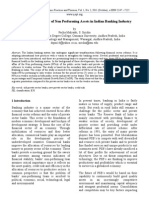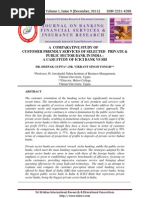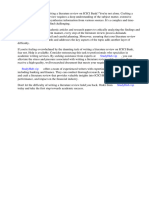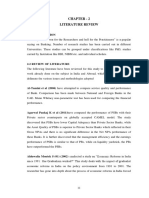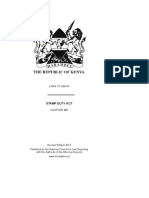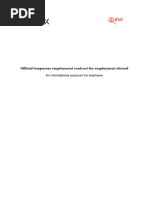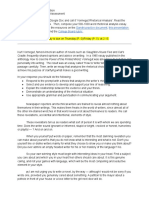0 ratings0% found this document useful (0 votes)
43 viewsLiterature Survey
Literature Survey
Uploaded by
shwetaThis literature review summarizes 10 academic studies on trends in the Indian banking sector from 2009 to 2015. Key findings include:
- Studies found shifts in commercial bank lending from priority sectors to retail and services. Reforms led to restructuring and cost reductions.
- Performance generally improved for merged public sector banks post-merger, while private banks showed more variability and risk.
- Technological advances like ATMs, internet banking, and financial inclusion efforts helped improve customer satisfaction, especially for private and new generation banks.
- Determinants of depositor behavior differed between public and private banks. Policy announcements particularly impacted private and foreign banks.
So in summary, the studies analyzed changes in the Indian
Copyright:
© All Rights Reserved
Available Formats
Download as DOCX, PDF, TXT or read online from Scribd
Literature Survey
Literature Survey
Uploaded by
shweta0 ratings0% found this document useful (0 votes)
43 views4 pagesThis literature review summarizes 10 academic studies on trends in the Indian banking sector from 2009 to 2015. Key findings include:
- Studies found shifts in commercial bank lending from priority sectors to retail and services. Reforms led to restructuring and cost reductions.
- Performance generally improved for merged public sector banks post-merger, while private banks showed more variability and risk.
- Technological advances like ATMs, internet banking, and financial inclusion efforts helped improve customer satisfaction, especially for private and new generation banks.
- Determinants of depositor behavior differed between public and private banks. Policy announcements particularly impacted private and foreign banks.
So in summary, the studies analyzed changes in the Indian
Original Title
LITERATURE SURVEY.docx
Copyright
© © All Rights Reserved
Available Formats
DOCX, PDF, TXT or read online from Scribd
Share this document
Did you find this document useful?
Is this content inappropriate?
This literature review summarizes 10 academic studies on trends in the Indian banking sector from 2009 to 2015. Key findings include:
- Studies found shifts in commercial bank lending from priority sectors to retail and services. Reforms led to restructuring and cost reductions.
- Performance generally improved for merged public sector banks post-merger, while private banks showed more variability and risk.
- Technological advances like ATMs, internet banking, and financial inclusion efforts helped improve customer satisfaction, especially for private and new generation banks.
- Determinants of depositor behavior differed between public and private banks. Policy announcements particularly impacted private and foreign banks.
So in summary, the studies analyzed changes in the Indian
Copyright:
© All Rights Reserved
Available Formats
Download as DOCX, PDF, TXT or read online from Scribd
Download as docx, pdf, or txt
0 ratings0% found this document useful (0 votes)
43 views4 pagesLiterature Survey
Literature Survey
Uploaded by
shwetaThis literature review summarizes 10 academic studies on trends in the Indian banking sector from 2009 to 2015. Key findings include:
- Studies found shifts in commercial bank lending from priority sectors to retail and services. Reforms led to restructuring and cost reductions.
- Performance generally improved for merged public sector banks post-merger, while private banks showed more variability and risk.
- Technological advances like ATMs, internet banking, and financial inclusion efforts helped improve customer satisfaction, especially for private and new generation banks.
- Determinants of depositor behavior differed between public and private banks. Policy announcements particularly impacted private and foreign banks.
So in summary, the studies analyzed changes in the Indian
Copyright:
© All Rights Reserved
Available Formats
Download as DOCX, PDF, TXT or read online from Scribd
Download as docx, pdf, or txt
You are on page 1of 4
https://www.ceicdata.
com/en/india/scheduled-commercial-banks-selected-financial-
ratios/scheduled-commercial-banks-return-on-assets
https://www.rbi.org.in/scripts/PublicationsView.aspx?id=14629
LITERATURE SURVEY: BANKING SECTOR
Roy (2016) [1] directed an investigation on bank lending to need and retail
sectors amid the period from 1996-97 to 2004-05. For this examination, 47
Indian planned business banks, which represents around 90-95 percent of bank
credit of all booked business banks were chosen. From this investigation,
unmistakably there has been an auxiliary move in credit conveyance of booked
business banks from need sectors i.e. agriculture, little scale ventures, to
services and retail sectors amid the most recent couple of years.
Bhadury Proff Subrato (2017) [2] directed study on "Business banking in India
new difficulties and openings after liberalization" This study uncovers that in
the financial sector, liberalization and technological leap forward has started a
rebuilding in our banking sector, which is precisely inversely to our organizing
standard. Taken a gander at from the regulatory edge our banking sector four
level system head office, zonal office, provincial office, and branch office, in
any case, computerization, LAN, interconnectivity, email and IT transformation
have brought the local and branch workplaces closer and numerous banks began
rebuilding notwithstanding returning to 3 level structures subsequently making
them cost viable and technologically redesigned. Thought about globalization
and rivalry, this repositioning was to a great degree fundamental. In the new
period, the banking rehearses are much the same as some other specialist co-op
and their exercises are getting re-imagined relatively consistently. To manage in
this setting too with profitability, business banks should take a gander at 3
noteworthy directional changes: rethink their technique entirely under risk-
return system, actualize business process re-building and patch up their
authoritative structure and system in accordance with worldwide standards.
Dhar V Ganga and Reddy G Nares (2017) [3] led study on "Mergers and
acquisitions in the Banking Sector-an Empirical Analysis" The prime goal of
this study is to break down the growth and performance of the example banks
amid pre and post merger periods. In light of the study it was seen that the
performance of the merged banks in regard to the growth of aggregate
resources, income, profits, investments and deposit saw a critical increment.
ICICI bank has accomplished the growth rate in all regards, acknowledges for
deposits, among the example banks. The study likewise features that SBI, BOB
and UBI have more noteworthy consistency in their performance, reflecting
lower risk looked by them. As against this Centurion Bank, HDFC bank and
ICICI bank have confronted more prominent irregularity and higher risk, along
these lines calling attention to that the public sector merged banks have
indicated better performance, with more prominent consistency and lower risk
when contrasted with private sector banks in India.
Kunjukunju Dr. Benson (2010) [4] "Reforms in Banking Sector and Their
Impact in Banking Services" In this study it has been examined that the
methodologies followed by the Indian Banks are still a long way from sufficient
and have not acquired the normal outcomes. The systematic arranging and
presentation of client situated and tweaked products and services by the Indian
Banks will assist them with competing and prevail in the contemporary
aggressive banking condition. In a focused business condition keeping in mind
the end goal to hold and enlarge the client base, the banks should start ventures
to better close to home contacts with their clients. The banks must focus on
improving nature of its work force and endeavour to create it further.
Kalluru Siva Reddy (2009) [5] led study on “Ownership structure, Performance
and Risk in Indian Commercial Banks" This study looks at the impact of
possession on performance and risk of business banks in India amid the period
1995-2007. The study utilizing t-test, settled impacts and random impacts
demonstrate, looks at whether there exists any noteworthy contrast in the
performance and risk among the state claimed banks, domestic private banks
and foreign banks, controlling different elements. The outcome indicate critical
contrasts in the performance advertisement risks and FBs appear to be more
profitable and more risk taking than both DPB and SOBs. Bank capital and
demand deposit are emphatically related and loans are contrarily connected with
bank profitability, where as size of bank and growth rate of economy are
adversely connected with bank.
Sultan Singh (2011) [6] "An Appraisal of the Banking Sector Reform in
India ‟ , Ph.D. Proposition Submitted in Development of Business
Management, Guru Jambheshwar University, Hisar (Haryana). The specialist
goes for evaluating the effect of the reforms on the operational performance and
proficiency of the Indian business banks. The factual device utilized in the study
is the ratio analysis for evaluating the performance of the chose business banks.
The study uncovered that aggregate pay as a level of working funds and/or add
up to resources, and spread as a level of aggregate salary/working funds/add up
to propels/add up to deposits have enhanced in the post-reform period when
contrasted with the pre-reform period in a large portion of the banks. Add up to
pay premium earned, other pay, spread, add up to costs, premium consumed,
working costs and foundation costs are comparatively more predictable in the
post-reform period. The hypothesis of the exploration demonstrates that the
profitability position has enhanced in post-reform period and it is being
acknowledged to some degree. It was seen that in the public sector banks the
size of NPAs has additionally decreased to some degree and nature of
administration has enhanced in the post-reform period along with decrease in
need sector lending in the deregulation time.
N. S. Varghese (2010) [7] is of the feeling that new generation private sector
banks with their most recent innovation can actualize e-banking and are
exceptionally favored by speculators in the share trading system. He likewise
brings up that unmistakable new generation private sector banks like HDFC and
ICICI have gone into web banking through which more prominent
accommodation is offered with lower transaction cost.
Singh Sultan and Komal (2009) [8] in the Business Intelligence Journal
exhibited a paper titled, "Effect of ATM on customer satisfaction a comparative
study of SBI, ICICI and HDFC bank. This paper displayed the effect of ATM
on customer satisfaction. This was a comparative study of three noteworthy
banks i.e. state bank of India, ICICI and HDFC bank. This paper had been
separated into two sections. First section displayed the presentation of ATM,
brief history of three banks. Second section introduced the outcome got based
on the data collected. To examine the data, different statistical techniques, for
example, normal, standard deviation and ordinary conveyance had been utilized
according to the prerequisite of the data. F test had additionally been utilized to
investigate the fluctuations. The customer satisfaction level had been broke
down in two terms i.e. material customer satisfaction level and dynamic
customer satisfaction level. This article presumed that material satisfaction level
was the most noteworthy in SBI; the second position was involved by ICICI
bank and third by HDFC bank. This was because of the size of the individual
bank and number of long periods of its foundation. Customer satisfaction in
terms of proficiency and performance, HDFC bank was at first position, second
was ICICI bank and third was SBI. Material customer satisfaction level was the
most astounding for SBI at 79%, second was possessed by ICICI bank with
77% and third by HDFC bank with 73%. Normal customer satisfaction level
was the most astounding in HDFC bank with 70%, in ICICI bank it is 60% and
SBI is at third place with 55%.
Ghosh and Das (2015) [9] directed an observational examination on depositor
train in the banking sector in India. This examination follows the determinants
of depositor train in Indian banking. Utilizing yearly information on business
banks covering the period 1996 to 2003, the discoveries uncover that, while
bank-particular elements are predominant if there should be an occurrence of
state-possessed banks, systematic factors have a tendency to overpower bank-
particular factors in clarifying conduct of depositors of private banks. If there
should be an occurrence of private and foreign banks, arrangement declarations
have an essential bearing on the reliant variable. For state-claimed banks, bigger
resource converts into higher deposit growth, recommending that depositors are
delicate to the 'to-enormous to-fall' impact. At last, guaranteed depositors tend
to practice teach by convincing banks to pay a higher cost on deposits.
Bhayani (2015) [10] led an experimental investigation on retail banking
mindfulness among 200 clients having their present records with private banks,
nationalized and co-agent banks in the Rajkot city of Gujarat. The goal of this
investigation was to look at the services given by various private sector banks in
the Rajkot city and additionally to know the clients' mindfulness about the
services gave and how frequently they used these services. This examination
inferred that in India, because of different elements like lack of education and so
on, the IT attention to the clients was still low. In this way, the banks expected
to put real endeavors towards instructing the clients for working up an 'IT astute
client base'.
IV. RECENT TRENDS AND DEVELOPMENTS IN BANKING SECTOR
Today, we are having a genuinely all around created banking system with
various classes of banks – public sector banks, foreign banks, private sector
banks, territorial rural banks and co-agent banks. The Reserve Bank of India
(RBI) is at the central of the considerable number of banks. The RBI's most
critical objective is to keep up money related dependability (direct and stable
expansion) in India. The RBI utilizes fiscal approach to keep up value security
and a satisfactory stream of credit. The rates utilized by RBI to accomplish the
bank rate, repo rate, turn around repo rate and the money reserve ratio.
Lessening inflation has been a standout amongst the most critical objectives for
quite a while. Growth and enhancement in banking sector has risen above limits
everywhere throughout the world. In 1991, the Government opened the
entryways for foreign banks to begin their operations in India and give their
extensive variety of offices, in this way giving a solid rivalry to the domestic
banks, and helping the clients in benefiting the best of the services. The Reserve
Bank in its offer to move towards the best international banking practices will
additionally hone the prudential standards and reinforce its administrator
system. There has been impressive advancement and broadening in the matter
of real business banks. Some of them have occupied with the zones of purchaser
credit, Visas, merchant banking, web and telephone banking, leasing, mutual
funds and so on. A couple of banks have officially set up auxiliaries for
merchant banking, leasing and mutual funds and numerous more are doing as
such. A few banks have initiated figuring business.
Manoj (2010) assess the determinant of profitability of old private sector banks especially in
Kerela State. He found that while non-interest income is important determinant of
profitability of new generation private sector banks, the old generation private sector banks
remained dependent in rural areas for their profitability. The study also stresses the crucial
linkage between Government Securities (G-Sec) and Net Interest Margin (NIM). Bansal
You might also like
- History of Video GamesDocument31 pagesHistory of Video GamesVigyani SumanNo ratings yet
- Financial Risk Management (PROJECT)Document72 pagesFinancial Risk Management (PROJECT)Vinayak Halapeti100% (3)
- Group 3 ResearchDocument56 pagesGroup 3 ResearchTirsolito Salvador67% (3)
- Synopsis GlobalisationDocument11 pagesSynopsis GlobalisationSumit Aggarwal100% (1)
- Performance of Banking Through Credit Deposit Ratio in Public Sector Banks in IndiaDocument5 pagesPerformance of Banking Through Credit Deposit Ratio in Public Sector Banks in Indiaaaditya01No ratings yet
- Comparative Study of Private and Public Sector BankDocument21 pagesComparative Study of Private and Public Sector BankbuddysmbdNo ratings yet
- Pre Merger and Post Merger Financial Analysis of Indian BankDocument12 pagesPre Merger and Post Merger Financial Analysis of Indian BankKRISHNA PRASAD SAMUDRALANo ratings yet
- Review of Literature On Public and Private BanksDocument8 pagesReview of Literature On Public and Private Banksekvxrxrif100% (1)
- Financial Performance of Private Sector Banks With Reference To ICICI Bank and Selected Private BanksDocument21 pagesFinancial Performance of Private Sector Banks With Reference To ICICI Bank and Selected Private BanksMayank TeotiaNo ratings yet
- ABCDDocument45 pagesABCDKartik GaurNo ratings yet
- Measuring Efficiency in Indian Commercial Banks With DEA and Tobit RegressionDocument6 pagesMeasuring Efficiency in Indian Commercial Banks With DEA and Tobit RegressioncharanNo ratings yet
- A Comparative Study of Financial Permormance of State Bank of India and ICICI BankDocument10 pagesA Comparative Study of Financial Permormance of State Bank of India and ICICI Bankprteek kumarNo ratings yet
- Wa0014 PDFDocument59 pagesWa0014 PDFUthappa T SNo ratings yet
- A Comparative Study of Non Performing Assets in Indian Banking IndustryDocument11 pagesA Comparative Study of Non Performing Assets in Indian Banking IndustryIJEPT Journal67% (6)
- IJCRT2302665Document7 pagesIJCRT2302665meetbhagat47No ratings yet
- Literature Review On Indian Banking SectorDocument7 pagesLiterature Review On Indian Banking Sectorafdtrzkhw100% (1)
- Literature Review of Public and Private Sector BankDocument4 pagesLiterature Review of Public and Private Sector BankfnraxlvkgNo ratings yet
- 2dharmendra S Mistry - Pdfa Comparative Study of The Profitability Performance in TheDocument15 pages2dharmendra S Mistry - Pdfa Comparative Study of The Profitability Performance in ThePsubbu RajNo ratings yet
- International Journal of Information Technology and Knowledge ManagementDocument6 pagesInternational Journal of Information Technology and Knowledge Managementrakeshkmr1186No ratings yet
- JETIR2302448Document7 pagesJETIR2302448Rupak RoyNo ratings yet
- Methodology To Predict NPA in Indian Banking System: Gourav Vallabh, Digvijay Singh, Ruchir Prasoon, Abhimanyu SinghDocument10 pagesMethodology To Predict NPA in Indian Banking System: Gourav Vallabh, Digvijay Singh, Ruchir Prasoon, Abhimanyu SinghBiswajit DasNo ratings yet
- Financial RiskDocument68 pagesFinancial RiskGouravNo ratings yet
- Sikkim Manipal University: "Comparative Study On Customer's Loyalty inDocument8 pagesSikkim Manipal University: "Comparative Study On Customer's Loyalty inSubrat PatnaikNo ratings yet
- Literature Review On Banking Services in IndiaDocument5 pagesLiterature Review On Banking Services in Indiaafmzvadopepwrb100% (1)
- Harish eDocument9 pagesHarish eTamil SelvamNo ratings yet
- Co OperativeDocument9 pagesCo OperativeDelete SinghNo ratings yet
- Literature Review of Indian Banking SectorDocument5 pagesLiterature Review of Indian Banking Sectorc5kby94s100% (1)
- A Study of Financial Performance Evaluation of Banks in IndiaDocument11 pagesA Study of Financial Performance Evaluation of Banks in IndiaRaghav AryaNo ratings yet
- Challenges Faced by Indian Banking IndustryDocument5 pagesChallenges Faced by Indian Banking IndustryPooja Sakru100% (1)
- NIER 71964 SHIV+SWAROOP+JHA Final Fisheries (7088+to+7095)Document8 pagesNIER 71964 SHIV+SWAROOP+JHA Final Fisheries (7088+to+7095)Purnendu SahuNo ratings yet
- Literature Review On Banking SectorDocument6 pagesLiterature Review On Banking Sectoraebvqfzmi100% (1)
- INSPIRA JOURNAL OF COMMERCEECONOMICS COMPUTER SCIENCEJCECS Vol 05 No 01 January March 2019 Pages 133 To 137Document5 pagesINSPIRA JOURNAL OF COMMERCEECONOMICS COMPUTER SCIENCEJCECS Vol 05 No 01 January March 2019 Pages 133 To 137sharonNo ratings yet
- Res PaperDocument6 pagesRes PaperTamil TrendingNo ratings yet
- A Study On Cooperative Banks in India With Special Reference To Lending PracticesDocument6 pagesA Study On Cooperative Banks in India With Special Reference To Lending PracticesSrikara Acharya100% (1)
- Abstract:: A Study On Mergers and Acquisition in Banking Industry of IndiaDocument4 pagesAbstract:: A Study On Mergers and Acquisition in Banking Industry of IndiaPotlamarri SumanthNo ratings yet
- T&D in Banking Sector (Arpit Shukla 18301B0007)Document12 pagesT&D in Banking Sector (Arpit Shukla 18301B0007)Arpit ShuklaNo ratings yet
- A Study On Customers Satisfaction-1102-With-cover-page-V2 Ex ProjectDocument16 pagesA Study On Customers Satisfaction-1102-With-cover-page-V2 Ex ProjectFelix ChristoferNo ratings yet
- Images - Download - Jbfsir - Jbfsir - December - 2011 - (Complete) - 2 Deepak Gupta A Comparative Study of Customer Friendly ServicesDocument12 pagesImages - Download - Jbfsir - Jbfsir - December - 2011 - (Complete) - 2 Deepak Gupta A Comparative Study of Customer Friendly ServicesAmit RajputNo ratings yet
- SaaniyyaahDocument8 pagesSaaniyyaahSaniya SanuzzNo ratings yet
- 1985-Article PaperDocument16 pages1985-Article Paperavikboss007No ratings yet
- Performance Appraisal in Indian Banking SystemDocument6 pagesPerformance Appraisal in Indian Banking Systemsagarsandeep090No ratings yet
- Icici BankDocument120 pagesIcici BankAshutosh TiwariNo ratings yet
- Merger and Acquisitions in The Indian BaDocument12 pagesMerger and Acquisitions in The Indian BaYitbarekNo ratings yet
- Lietrature ReviewDocument6 pagesLietrature ReviewTamil TrendingNo ratings yet
- Literature Review On Loan RecoveryDocument7 pagesLiterature Review On Loan Recoveryc5m07hh9No ratings yet
- Synopsis On Comparative Study On ICICI and SBIDocument9 pagesSynopsis On Comparative Study On ICICI and SBIitsruchika18100% (7)
- Corrections of Research ReportDocument5 pagesCorrections of Research ReportDaman Deep Singh ArnejaNo ratings yet
- A Study On Non-Performing Assets (NPA) of Public and Private Sector Banks in IndianDocument8 pagesA Study On Non-Performing Assets (NPA) of Public and Private Sector Banks in Indiansatakshikumari789No ratings yet
- Synopsis On A Comparative Study On The BDocument6 pagesSynopsis On A Comparative Study On The Bharshal maliNo ratings yet
- Literature Review of Icici BankDocument8 pagesLiterature Review of Icici Bankaflsqyljm50% (2)
- Literature ReviewDocument12 pagesLiterature ReviewAnonymous ckTjn7RCq8No ratings yet
- Vol 1 Issue 1 Art 1Document17 pagesVol 1 Issue 1 Art 1Sabana AsmiNo ratings yet
- Desertation Report 2Document57 pagesDesertation Report 2negishubham717No ratings yet
- Kavya S ReportDocument56 pagesKavya S Reportlakshmankm67No ratings yet
- Presentation 1Document6 pagesPresentation 1rushijari08No ratings yet
- Retail Banking Services in Sbi and Icici - SynopsisDocument10 pagesRetail Banking Services in Sbi and Icici - Synopsisammukhan khanNo ratings yet
- Thesis Banking SectorDocument9 pagesThesis Banking Sectormeganespinozadallas100% (4)
- A Study of Various Types of Loans of Selected Public and Private Sector Banks With Reference To Npa in State HaryanaDocument9 pagesA Study of Various Types of Loans of Selected Public and Private Sector Banks With Reference To Npa in State HaryanaIAEME PublicationNo ratings yet
- Literature Review Banking SectorDocument7 pagesLiterature Review Banking Sectoreubvhsvkg100% (1)
- T R A N S F O R M A T I O N: THREE DECADES OF INDIA’S FINANCIAL AND BANKING SECTOR REFORMS (1991–2021)From EverandT R A N S F O R M A T I O N: THREE DECADES OF INDIA’S FINANCIAL AND BANKING SECTOR REFORMS (1991–2021)No ratings yet
- EIB Working Papers 2019/10 - Structural and cyclical determinants of access to finance: Evidence from EgyptFrom EverandEIB Working Papers 2019/10 - Structural and cyclical determinants of access to finance: Evidence from EgyptNo ratings yet
- (Digest) Abakada v. PurisimaDocument5 pages(Digest) Abakada v. PurisimaJechel TBNo ratings yet
- Chess Is Fun The French MacCutcheon - Jon EdwardsDocument104 pagesChess Is Fun The French MacCutcheon - Jon EdwardsEzequiel Meler100% (1)
- Lab Report Phy210 Group 9 As1202b Siti Nur Khadijah Farra AlliyahDocument6 pagesLab Report Phy210 Group 9 As1202b Siti Nur Khadijah Farra AlliyahFARRA ALLIYAH MOHD FAIZULNo ratings yet
- StampDuty MinDocument81 pagesStampDuty MinDeborah Diesbecq100% (2)
- 22 đề vào 10 hs cơ bảnDocument47 pages22 đề vào 10 hs cơ bảnngocnth12No ratings yet
- Perdev Module 1Document12 pagesPerdev Module 1Eunice SiervoNo ratings yet
- Old ResumeDocument6 pagesOld ResumeRushikesh GirameNo ratings yet
- LearnEnglish MagazineArticle BeYourOwnInvestigativeJournalist 0Document3 pagesLearnEnglish MagazineArticle BeYourOwnInvestigativeJournalist 0Ilaria BaisiNo ratings yet
- ENSONIQ KS-32 Musicians ManualDocument260 pagesENSONIQ KS-32 Musicians ManualtorcuatoburoneNo ratings yet
- Liminal It 1Document3 pagesLiminal It 1Kit DiazNo ratings yet
- Islomov Sardorbek EpodexDocument6 pagesIslomov Sardorbek EpodexskomarohovNo ratings yet
- Air Handling Units: Technical CatalogDocument72 pagesAir Handling Units: Technical Catalogarindam02041985No ratings yet
- Gandhi Practice Document This Presentation About Essay Composition College Board RubricDocument3 pagesGandhi Practice Document This Presentation About Essay Composition College Board RubricMandila BudhathokiNo ratings yet
- Jyoti AhujaDocument2 pagesJyoti Ahujadeepaman32045No ratings yet
- A1 RelationFunctionRecurrenceDocument9 pagesA1 RelationFunctionRecurrenceDESI DWI PURWASIHNo ratings yet
- The Role of Micro and Smallscale Enterprises in Poverty Reduction: The Case of Dugda Dewa Woreda Finchawa Town Southern EthiopiaDocument20 pagesThe Role of Micro and Smallscale Enterprises in Poverty Reduction: The Case of Dugda Dewa Woreda Finchawa Town Southern Ethiopiaiaset123No ratings yet
- Flood Control and Drainage Management Structures YaredDocument65 pagesFlood Control and Drainage Management Structures YaredMelikteNo ratings yet
- DLP Life Skills Mod1 LAS8 Learning Style Assessment - Listening and ViewingDocument1 pageDLP Life Skills Mod1 LAS8 Learning Style Assessment - Listening and ViewingGan CapinNo ratings yet
- Keyboard InstrumentsDocument5 pagesKeyboard InstrumentsADENIYI sethNo ratings yet
- h131 Est2-2c-Mv4 Cx-Thermo Support Software Ver. 4. Datasheet enDocument2 pagesh131 Est2-2c-Mv4 Cx-Thermo Support Software Ver. 4. Datasheet enLê Anh TuấnNo ratings yet
- CHAPTER 5 Sales ManagementDocument50 pagesCHAPTER 5 Sales ManagementFelicia TangNo ratings yet
- Freedom WritersDocument2 pagesFreedom Writersliliana ursuNo ratings yet
- NAAG Backpage Sign On 08-31-11Document7 pagesNAAG Backpage Sign On 08-31-11Emily BabayNo ratings yet
- Introduction To Peptides in Cosmetic Science 1701831851Document8 pagesIntroduction To Peptides in Cosmetic Science 1701831851csk86No ratings yet
- (STATISTICS I.com (Xii) 2023) Solved Trget Paper by Sir Irfan Jan-1Document5 pages(STATISTICS I.com (Xii) 2023) Solved Trget Paper by Sir Irfan Jan-1mohsinbeforwardNo ratings yet
- P3 3B Gutierrez JohnPaulDocument4 pagesP3 3B Gutierrez JohnPauljp gutierrezNo ratings yet
- Manos Accelerator - List of Accelerators and IncubatorsDocument49 pagesManos Accelerator - List of Accelerators and Incubatorstripathi.ankit557No ratings yet
- Media Management Cases and Analysis by Ameyu EtanaDocument17 pagesMedia Management Cases and Analysis by Ameyu EtanaAmeyu Etana KaloNo ratings yet













